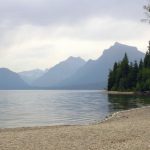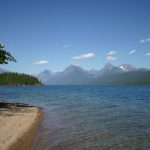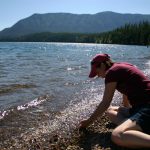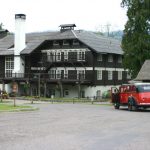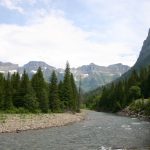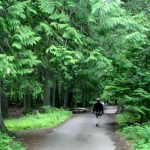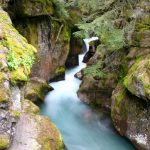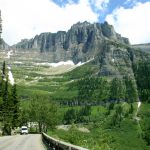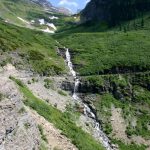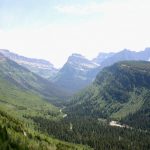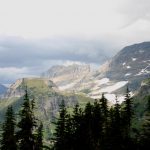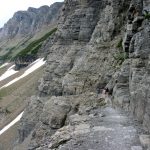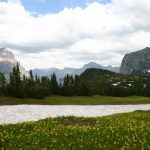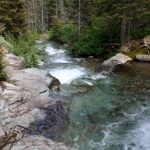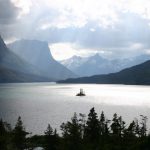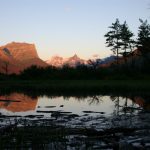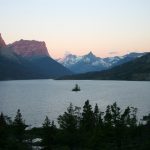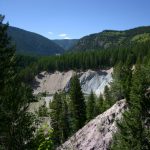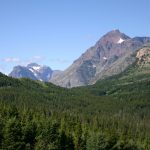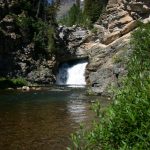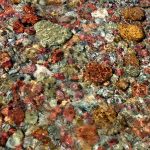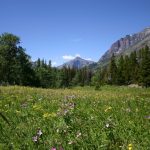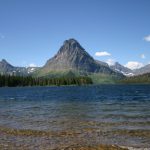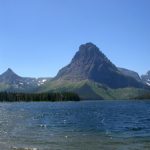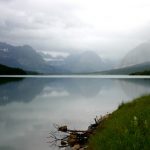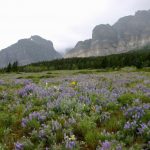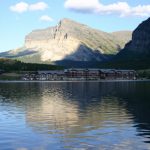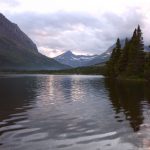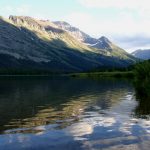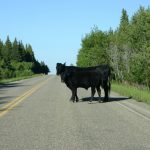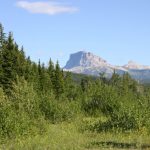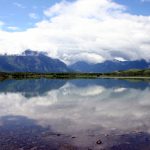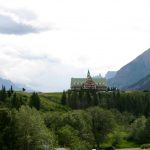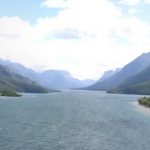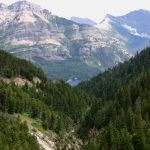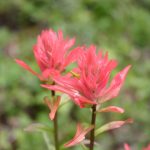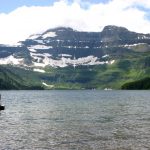
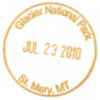 Glacier National Park, Montana, was established in 1910, has been called the “Crown of the Continent.” It is home to some of the last remaining glaciers along the continental divide in the lower 48 states and a spectacular arrangement of glacier-carved peaks, turquoise lakes and diverse wildlife. Glacier is paired with Waterton Lakes National Park, Alberta, Canada, as Waterton-Glacier International Peace Park
Glacier National Park, Montana, was established in 1910, has been called the “Crown of the Continent.” It is home to some of the last remaining glaciers along the continental divide in the lower 48 states and a spectacular arrangement of glacier-carved peaks, turquoise lakes and diverse wildlife. Glacier is paired with Waterton Lakes National Park, Alberta, Canada, as Waterton-Glacier International Peace Park
Visitor Rating (write your own review below)
Top 5 National Park!
ILNP Rating![]()
Scenery![]()
Wildlife![]()
Diversity![]()
ILNP Park Review
In a Word. “Regal”
“He who forms the mountains, creates the wind, and reveals his thoughts to man, he who turns dawn to darkness, and treads the high places of the earth–the Lord God Almighty is his name.” -Amos 4:13
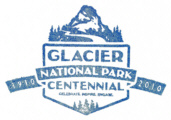 Our Visit. We visited Glacier NP in July 2010, Glacier’s centennial year. We took a 4-day trip just to see the park.
Our Visit. We visited Glacier NP in July 2010, Glacier’s centennial year. We took a 4-day trip just to see the park.
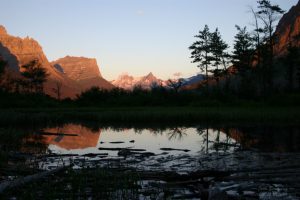
Mountain peaks around St Mary Lake at sunrise (July)
Our Weather. We spent 3 days in the park. The first half was mostly cloudy and rainy, and the last half was sunny. July temperatures were in the mid 80s in the low areas and around 60 in the mountains.
Overall Impression. Glacier National Park is truly majestic and worthy of weeks of exploration. Glacier’s beauty lies in its numerous turquoise lakes set among spectacularly carved peaks with mantles of lush forest. On top of this, Glacier is inhabited by magnificent creatures such as grizzly bear, moose and mountain goats. While all of the park shares these common features, their arrangements in different sections of the park are unique enough that you never grow tired of seeing them. Glacier is also a great mix of accessibility–roads take you to many major areas of the park, but there are still hundreds of thousands of acres of wilderness in which hikers can find seclusion from the crowds.
Favorite Spot. St Mary Lake

Typical view through your car window on Going to the Sun Road (July)
Minimum Time Required. With half a day, you can explore any single section of the park by car and take a few short hikes (Lake McDonald, St Mary Lake, Many Glacier, Two Medicine, Waterton). It would be a shame to have this little time, but any excursion into the park is worth the entrance fee. Because of the park’s remoteness, it will probably take 2-4 hours to get to the park by car from the nearest cities (Missoula, Great Falls, Calgary) making this a full-day proposition. Another option if you’re just driving through is to take Going to the Sun Road through the park. This will take you past two of the park’s major lakes and across the continental divide at Logan Pass. Along the way, you’ll see spectacular mountains, waterfalls and perhaps a mountain goat or two. The road is only open completely from June-September depending on snow conditions, so check with the NPS here before setting out.
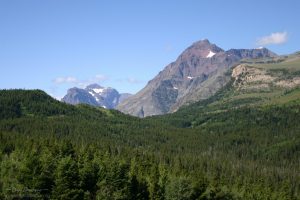
View into Two Medicine area from the highway (July)
A Longer Visit. We recommend spending at least 3 days in the park, but it would be easy to spend a week there. Road access divides the park into many sections including Lake McDonald, St Mary Lake, Many Glacier, Two Medicine and Waterton Lakes NP in Canada. Plan on spending 1/2 to a full day in each section you want to visit (at a minimum). The Lake McDonald area has the most options for lodging outside of the park due to its proximity to the towns of Whitefish and Kalispell, but each area has its own cluster of lodging. Unless you plan your trip at least 9-12 months in advance, lodging availability will probably be the determining factor of your “home base” for visiting the park. If you want to see as much of the park as possible (to include Waterton in Canada), we recommend staying in St Mary, Montana. To give you an example itinerary, we flew into Missoula, drove up to Whitefish and spent the night. The next day, we drove Going to the Sun Road to St Mary. On day 2 in the park, we drove up to Many Glacier and Waterton before returning to St Mary. On day 3, we drove to Two Medicine and around the south side of the park. We were able to spend a couple more hours in the Lake McDonald area (to make up for our rainy day 1) before heading back to Missoula.
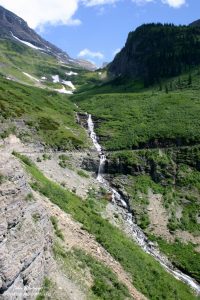
One of the amazing sights on Going to the Sun Road. This waterfall passes under an arch in the road (July)
Going to the Sun Road
Going to the Sun Road, completed in 1932, is considered by many to be one of the most beautiful highways in the US. The road traverses the continental divide at Logan Pass and connects the Lake McDonald area with the St Mary Lake area. Regardless of where you are staying, this is a “must see.” If you can manage it, the road is best traversed from east to west starting at St Mary, Montana and ending at West Glacier, Montana because the sun will be illuminating the central mountain peaks in front of you in the morning and the mountain peaks behind you in the afternoon. If you dedicate a full day to this drive, you’ll have plenty of time to enjoy some of the shorter hikes described in the St Mary Lake and Lake McDonald sections. Once you’ve left the St Mary Lake area, the road quickly ascends toward Logan Pass. There aren’t many short hikes before the pass, but there are several pull-offs for sights such as Jackson Glacier.

This portion of the divide is known as the Garden Wall. You can hike along its south face if you have the nerve and stamina (July)
At Logan Pass, you’ll find hikes for all skill levels as long as you can find a parking spot (or ride the bus). The Hidden Lake Nature Trail starts at the Logan Pass Visitors Center. While the trail goes 3 miles to the lake, you don’t have to hike very far to see snow lilies (early season), squirrels and hopefully a mountain goat (we didn’t see any, but most people do). If this trail is crowded, consider an out-and-back on the Highline Trail instead to get a great view of the Garden Wall, a row of peaks that forms part of the continental divide. The trail starts across the road from the parking lot and descends into meadows of wildflowers before setting out along a narrow ledge carved into the Garden Wall, I would not recommend bringing young children on this hike as the drop off is steep, and there is no barrier between the path and the cliff!
Setting out from Logan Pass eastward, the road passes through a spectacular array of waterfalls which flow down the mountainside and under, or in the case of the Weeping Wall, onto the road (you can put your hands out into the spray from your car). There aren’t many short hikes along this stretch, but there are places like The Loop to get out of the car and get a better look (though the view from the car is pretty good). Before long, you’ll have descended into the Lake McDonald area and can enjoy some of the short hikes and great vistas there before ending your drive at West Glacier.
Lake McDonald Area

Lake McDonald on an overcast day. The rain may not be as enjoyable as sunshine, but the mountains look no less majestic (July)
This is the area most people visit first because most of the lodging is on this side of the park. In addition to lodging in West Glacier, Columbia Falls and Whitefish, there is the Lake McDonald Lodge and Apgar Village Lodge in the park. The lake itself is nearly 10 miles long and is lined with the smooth and colorful stones left by glaciers characteristic of all the lakes in the park. The lake is ringed with mountains, but the most spectacular are on the east end, toward the center of the park. If arriving via West Glacier, stop at the Apgar Visitor Center to get information and pick up souvenirs or a bite to eat. If you continue west past Apgar, you’ll find Fish Creek, a nice spot for picnicking or wading on the west side of the lake. Beyond Fish Creek is the Inside North Fork Road if you want to get away from the crowds and explore the northwest portion of the park.
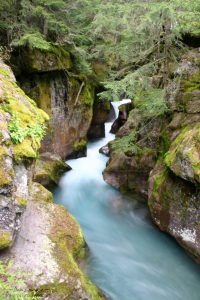
Turquoise water of Avalanche Creek as it cascades through Avalanche Gorge on the Trail of the Cedars
From Apgar, you can take Going to the Sun Road along the east side of the lake. There are several pull-offs for views of the lake with the mountains in the background as well as the Lake McDonald lodge about 3/4 of the way up the lake. There are hikes along the lake, but for the best short hike, continue past the lake on Going to the Sun Road to the Avalanche Creek area. Stop at McDonald Falls and spend a few minutes on the platform admiring the setting and splashing water. At Avalanche Creek, find a parking spot (this can be tough) and hike the easy Trail of the Cedars loop. You’ll walk among some of the remaining cedar trees (many were destroyed by a fire) and along Avalanche Creek. Halfway around the loop is a beautiful view up Avalanche Gorge where turquoise water falls through a narrow canyon.
St Mary Lake Area
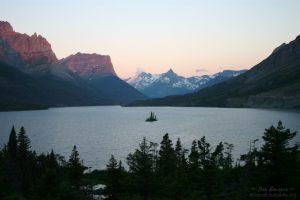
Sunrise just illuminates the peaks around St Mary Lake. The speck in the middle is Wild Goose Island (July)
In my opinion, St Mary Lake is the most spectacular of the major lakes in the park, especially in the morning when the sun illuminates the peaks at the east end of the lake. You can stay in the park at the Rising Sun Motor Lodge or in a campground, or you can stay in St Mary, Montana. We stayed at the St Mary Lodge and loved it–it’s only a few hundred yards from the park entrance. Starting at the St Mary Visitor Center, you can pick up a hiking map and some tips from the Rangers. You’ll soon be passing St Mary Lake and the Rising Sun area where you can purchase a ride on a boat across the lake if you have time. In early summer and even into July, this part of the park is covered with wildflowers. Soon, you’ll reach the classic vista of Wild Goose Island on the west end of St Mary Lake. Be sure to stop and take some photos of the layers of jagged peaks that surround this blue water. Heading east, you can stop at Sunrift Gorge where you can take a very short hike to see several small waterfalls or a longer hike to Baring Falls and Sun Point on the lake. A few miles further east is a parking lot for St Mary Falls. It’s a 1.6 mile round trip to the falls (3.0 miles to see Virginia Falls as well). Our weather and time prevented us from making this hike, but it was highly recommended.
Two Medicine Area
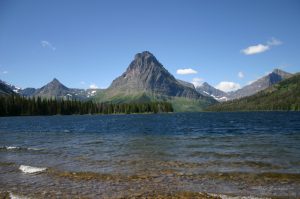
Two Medicine Lake is a lot less visited than McDonald and St Mary, but it’s no less spectacular (July)
The Two Medicine Area, on the southeast side of the park, is a beautiful spot to visit if you have a spare day or if you want to enjoy a little section of Glacier that’s further from the summer crowds. The closest lodging is in East Glacier Park, home to the Glacier Park Lodge built in 1912 to serve passengers brought in by the Great Northern Railway. The Two Medicine Area is centered on beautiful Two Medicine Lake and is accessed by a short road. Along the road, be sure to stop for the short hike to Running Eagle Falls which pours out of a tunnel in the side of a cliff. The water at the base of the falls is slow and shallow enough to dip your feet into if you’re feeling hot–it will cool you off! The road ends at Two Medicine where you can hike or take a boat to the other end of the lake for hikes to Twin Falls, Upper Two Medicine Lake and beyond if you have the time and stamina. We stayed in the Two Medicine area and took the 1.2 mile round trip hike to Appistoki Falls. It was a nice hike, but we would have been better off staying closer to the lake. DO NOT take small children to Appistoki Falls. The path near the falls slopes toward a cliff, and there are no guardrails! There are several other hikes in this area which would occupy an entire day or more. We went to East Glacier, just outside Two Medicine, for lunch and ate at Luna’s Cafe–we highly recommend it, and you have to try the fried green beans.

Sunset over Swiftcurrent Lake in the Many Glacier area (July)
Many Glacier Area
The Many Glacier Area, just west of Babb, Montana is about a 30 minute drive from St Mary, or you can stay in the historic Many Glacier Hotel right on Swiftcurrent Lake or the Swiftcurrent Motor Inn at the end of the road. The Many Glacier area had the most abundant wildflowers of any area we saw in the park, and the scenery surrounding Swiftcurrent Lake rivals any in the park. Most of the hikes in Many Glacier are long, and some (as the name implies) take you to active glaciers. If you’re looking for a short hike, take the Swiftcurrent Nature Trail around the lake for views of mountains and wildlife. This is a nice area to spend sunset. Also, be sure to visit Many Glacier Hotel and walk down the first-floor hallway. There is a nice exhibit of “then and now” photos of glaciers in the park which show the extent of the recession since the 1930s.
Waterton Lakes NP, Alberta, Canada
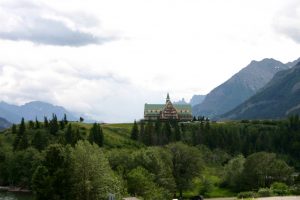
The historic Prince of Wales Hotel occupies a prominent vista in the middle of Waterton Lakes NP (July)
When you pick up your park map at Glacier, you’ll notice it says “Waterton-Glacier.” In 1932, the governments of the US and Canada linked Glacier NP and Waterton Lakes NP as the first International Peace Park. Despite the link and an 18 mile shared boundary, Waterton Lakes is operated independently of Glacier. To visit Waterton, you have to pass through Canadian customs (requires a passport) and pay a separate entrance fee for Waterton (about $7.50 per person for a day pass in 2010). Despite this, it’s worth the trip if you have an extra day. The drive itself up Chief Mountain Highway is beautiful. Waterton is different than Glacier in many ways, but the scenery is roughly equivalent–it doesn’t get any better just because it’s in Canada. One of the unique things about Canada’s half of Waterton-Glacier is the town of Waterton in the middle of the park. Canadian families live here, and the town is a bustling hub of tourism, eating and shopping. While this first struck us as odd for a National Park, we rather enjoyed being able to hike the wilderness during the day and to walk around and shop and enjoy a nice dinner surrounded by spectacular scenery in the evening.
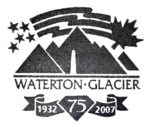 The best views in Waterton Lakes can be had from the historic Prince of Wales Hotel, set on the northern shore of Upper Waterton Lake, but there’s much more to Waterton. Be sure to make the scenic drive on Akamina Parkway to Cameron Lake where you can rent a canoe for further exploring. Along the road, there’s a great short hike to Crandell Lake (1.5 miles round trip). The trail offers views of the mountains around Waterton Lake and takes you to a small and secluded lake. Along the trail we saw an incredible variety of pristine wildflowers. The road to Cameron Lake is also the best area for spotting bears. We saw five black bears from the road but no grizzlies. If you have more time, you can take a shuttle to Red Rock Canyon where you explore rocks with bizarre color patterns.
The best views in Waterton Lakes can be had from the historic Prince of Wales Hotel, set on the northern shore of Upper Waterton Lake, but there’s much more to Waterton. Be sure to make the scenic drive on Akamina Parkway to Cameron Lake where you can rent a canoe for further exploring. Along the road, there’s a great short hike to Crandell Lake (1.5 miles round trip). The trail offers views of the mountains around Waterton Lake and takes you to a small and secluded lake. Along the trail we saw an incredible variety of pristine wildflowers. The road to Cameron Lake is also the best area for spotting bears. We saw five black bears from the road but no grizzlies. If you have more time, you can take a shuttle to Red Rock Canyon where you explore rocks with bizarre color patterns.
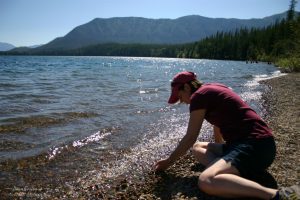
All of the lakes, including Lake McDonald here, are lined with smooth stones of amazing color left by the retreating glaciers. Take a few minutes to inspect them carefully (July)
Suggestions. If you’re planning to spend most of your time on the roads, remember, the road system was designed in the early days of the automobile. Roads are narrow (many are restricted to vehicles under 21 feet), and pullouts are small. If you’re traveling during peak season on a weekend, expect a shortage of parking in the most popular areas (Logan Pass, Lake McDonald Lodge, Avalanche Creek). As an alternative, consider touring Going to the Sun Road on one of the classic red buses (costs extra). If you do end up driving, PLEASE stop only in a pull-off–while some of the best views from the road don’t have their own pull-off, there are many other drivers behind you who would like to use the road.

Black bears outnumber grizzlies in this area. Here a young cinnamon-colored black bear wanders close to the road in Waterton Lakes (July)
This is BEAR COUNTRY! Pay attention to the signs and information in the park literature to avoid surprising a bear. Bottom line: talk loudly and often when hiking and know what to do if you get attacked. Glacier is not only bear country, it’s MOSQUITO COUNTRY. The mosquitoes in this area don’t buzz, they rattle like Harley Davidsons. They are huge, and there are billions of them, so bring a good repellent and use it.
We are from Colorado, so we’re used to the weather changing rapidly, but we have never seen it change as quickly as it did in Glacier. Bring a rain jacket and something warm if you’re wearing shorts and a t-shirt, just in case. Also, this is high altitude and drier than you think, so wear sunscreen and drink lots of water.
Nearby Towns Babb, St Mary, East Glacier, West Glacier, Columbia Falls, Whitefish, Kalispell, Missoula, Great Falls (Montana), Cardston, Pincher Creek, Lethbridge, Calgary (Alberta, Canada)
Other Nearby Attractions Flathead Lake, Big Mountain Ski Resort
Official NPS Website Glacier NP
- Lake McDonald on an overcast day. The rain may not be as enjoyable as sunshine, but the mountains look no less majestic (July)
- A wind-whipped Lake McDonald as seen from Fish Creek (July)
- All of the lakes, including Lake McDonald here, are lined with smooth stones of amazing color left by the retreating glaciers. Take a few minutes to inspect them carefully (July)
- The Lake McDonald Lodge is one of the many historic hotels in Waterton-Glacier. Note the “red bus” parked in front–these vehicles have been toting tourists over Logan Pass since 1932 (July)
- There are small pulloffs all along Going to the Sun Road. This one near the Avalanche Creek area gives a good look at McDonald Creek and the mountains soon to be traveled (July)
- Turquoise water of McDonald Creek as seen from the overlook at McDonald Falls (July)
- The Trail of the Cedars is a short and pleasant hike with views of lush forest and a nice waterfall through a narrow gorge (July)
- Turquoise water of Avalanche Creek as it cascades through Avalanche Gorge on the Trail of the Cedars
- Typical view through your car window on Going to the Sun Road (July)
- One of the amazing sights on Going to the Sun Road. This waterfall passes under an arch in the road (July)
- The continental divide begins to dominate the view as you climb westward toward Logan Pass on Going to the Sun Road (July)
- This portion of the divide is known as the Garden Wall. You can hike along its south face if you have the nerve and stamina (July)
- A look at the narrow Highline Trail along the Garden Wall (July)
- Fields of snow lilies adorn the top of Logan Pass, seen here from the Hidden Lake Nature Trail (July)
- Snow lilies dominate the meadows on Logan Pass, even as late as July
- Sunrift Gorge, not far from St Mary Lake, is a long stretch of cataracts that’s easily accesible from Going to the Sun Road
- St Mary Lake can be very moody. This is the view over Wild Goose Island after an afternoon storm (July)
- Another view of Wild Goose Island on a clear day (July)
- Mountain peaks around St Mary Lake at sunrise (July)
- Sunrise just illuminates the peaks around St Mary Lake. The speck in the middle is Wild Goose Island (July)
- Early morning reflections at the east end of St Mary Lake (July)
- Going to the Sun Road is best traveled starting from St Mary in the morning and going west. Here you can see how the morning sun illuminates the peaks in front of you in the Rising Sun area (July)
- One obscure section of the park is Goat Lick Overlook. This lookout is easily accessed via highway US 2 near Walton, Montana on the south side of the park. As was normal for us, no goats (July)
- View into Two Medicine area from the highway (July)
- Running Eagle Falls (also known as Trick Falls) is accessed via an easy trail in the Two Medicine area. What makes the falls unique is its exit from a tunnel in the hillside. Early in the season, there is a second falls on top of the first (July)
- The water in the streams in Glacier is pristine, and like the lakes, the streams are lined with multi-colored, glacially smoothed rocks like these in the Two Medicine River (July)
- The wildflowers were thickest on the east side of the park. Here is a field near Two Medicine Lake (July)
- Two Medicine Lake is a lot less visited than McDonald and St Mary, but it’s no less spectacular (July)
- Glacier is a great place for panorama photos like this one at Two Medicine Lake (July)
- We had clouds and rain for our first day-and-a-half. This is the view across Lake Sherburne in the Many Glacier area (July)
- Many Glacier has one of the heaviest concentration of wildflowers in Glacier. Here is a field of lupine and other flowers adjacent to Lake Sherburne (July)
- The Many Glacier Hotel sits on the shore of Swiftcurrent Lake and is set nicely among the mountains (July)
- Sunset over Swiftcurrent Lake in the Many Glacier area (July)
- The Swiftcurrent Nature Trail winds around Swiftwater Lake. This is a nice place to spend sunset for both scenery and wildlife (July)
- Here’s a good example of the wildlife we saw on the way to Waterton Lakes. Be sure to keep your eyes on the road and not glued to the scenery (July)
- Chief Mountain dominates the horizon on the Chief Mountain Highway between Glacier and Waterton Lakes (July)
- A bridge across the Waterton River provides a great opportunity to look down into Waterton Lakes (July)
- The historic Prince of Wales Hotel occupies a prominent vista in the middle of Waterton Lakes NP (July)
- The Prince of Wales Hotel owns this commanding view of Upper Waterton Lake (July)
- Waterton is no less awesome for panos. Here is the view of Upper Waterton Lake from just outside the Prince of Wales Hotel (July)
- Akamina Parkway to Cameron Lake offers some great vistas of Waterton (July)
- Black bears outnumber grizzlies in this area. Here a young cinnamon-colored black bear wanders close to the road in Waterton Lakes (July)
- The trail to Crandell Lake in Waterton Lakes is lined with wildflowers in the summer including this Indian Paintbrush (July)
- Crandell Lake offers some seclusion from the busier spots at Waterton or Cameron Lake. It can be reached by a 1 1/2 mile round trip hike (July)
- Cameron Lake in Waterton Lakes NP offers great views of glaciated peaks. You can rent a boat or canoe at the lake for a closer look (July)
Write Your Own Review

